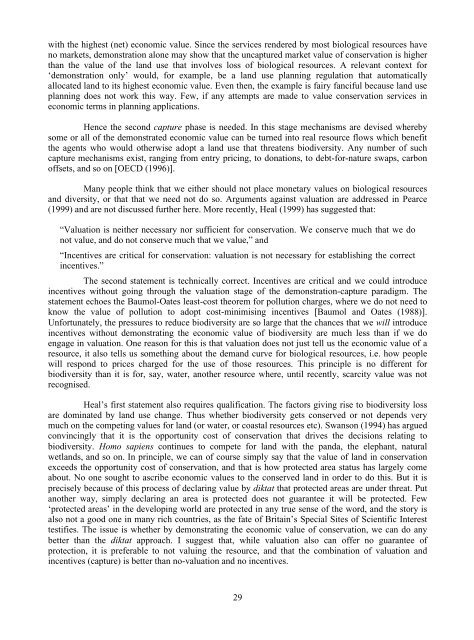with the highest (net) economic value. Since the services rendered by most biological resources haveno markets, demonstration alone may show that the uncaptured market value <strong>of</strong> conservation is higherthan the value <strong>of</strong> the land use that involves loss <strong>of</strong> biological resources. A relevant context for‘demonstration only’ would, for example, be a land use planning regulation that automaticallyallocated land to its highest economic value. Even then, the example is fairy fanciful because land useplanning does not work this way. Few, if any attempts are made to value conservation services ineconomic terms in planning applications.Hence the second capture phase is needed. In this stage mechanisms are devised wherebysome or all <strong>of</strong> the demonstrated economic value can be turned into real resource flows which benefitthe agents who would otherwise adopt a land use that threatens biodiversity. Any number <strong>of</strong> suchcapture mechanisms exist, ranging from entry pricing, to donations, to debt-for-nature swaps, carbon<strong>of</strong>fsets, and so on [<strong>OECD</strong> (1996)].Many people think that we either should not place monetary values on biological resourcesand diversity, or that that we need not do so. Arguments against valuation are addressed in Pearce(1999) and are not discussed further here. More recently, Heal (1999) has suggested that:“<strong>Valuation</strong> is neither necessary nor sufficient for conservation. We conserve much that we donot value, and do not conserve much that we value,” and“Incentives are critical for conservation: valuation is not necessary for establishing the correctincentives.”The second statement is technically correct. Incentives are critical and we could introduceincentives without going through the valuation stage <strong>of</strong> the demonstration-capture paradigm. Thestatement echoes the Baumol-Oates least-cost theorem for pollution charges, where we do not need toknow the value <strong>of</strong> pollution to adopt cost-minimising incentives [Baumol and Oates (1988)].Unfortunately, the pressures to reduce biodiversity are so large that the chances that we will introduceincentives without demonstrating the economic value <strong>of</strong> biodiversity are much less than if we doengage in valuation. One reason for this is that valuation does not just tell us the economic value <strong>of</strong> aresource, it also tells us something about the demand curve for biological resources, i.e. how peoplewill respond to prices charged for the use <strong>of</strong> those resources. This principle is no different forbiodiversity than it is for, say, water, another resource where, until recently, scarcity value was notrecognised.Heal’s first statement also requires qualification. The factors giving rise to biodiversity lossare dominated by land use change. Thus whether biodiversity gets conserved or not depends verymuch on the competing values for land (or water, or coastal resources etc). Swanson (1994) has arguedconvincingly that it is the opportunity cost <strong>of</strong> conservation that drives the decisions relating tobiodiversity. Homo sapiens continues to compete for land with the panda, the elephant, naturalwetlands, and so on. In principle, we can <strong>of</strong> course simply say that the value <strong>of</strong> land in conservationexceeds the opportunity cost <strong>of</strong> conservation, and that is how protected area status has largely comeabout. No one sought to ascribe economic values to the conserved land in order to do this. But it isprecisely because <strong>of</strong> this process <strong>of</strong> declaring value by diktat that protected areas are under threat. Putanother way, simply declaring an area is protected does not guarantee it will be protected. Few‘protected areas’ in the developing world are protected in any true sense <strong>of</strong> the word, and the story isalso not a good one in many rich countries, as the fate <strong>of</strong> Britain’s Special Sites <strong>of</strong> Scientific Interesttestifies. The issue is whether by demonstrating the economic value <strong>of</strong> conservation, we can do anybetter than the diktat approach. I suggest that, while valuation also can <strong>of</strong>fer no guarantee <strong>of</strong>protection, it is preferable to not valuing the resource, and that the combination <strong>of</strong> valuation andincentives (capture) is better than no-valuation and no incentives.29
Additionally, valuation does not just tell us that something is valuable. We learn so muchmore from the process <strong>of</strong> valuation, especially if we adopt stated preference techniques. We learnwhat people care about, what their motives are for conservation, what their reactions would be todifferent management objectives. It is worth noting that in most stated preference techniques, thequestion about willingness to pay is only a tiny part <strong>of</strong> the full questionnaire. But even if we did notlearn these things, the valuation itself would still be immensely important. Suppose people express alow conservation value for an area, but we go ahead and protect it nonetheless. This is a recipe fordestruction because we know from the valuation exercise that people do not value the area highly.They will put the pressure on to convert it to some other use, and that is exactly what is happening inmany, many so-called protected areas. So, why are we successful in protecting some areas, in a more,or less, complete fashion? One clue lies in the opportunity cost <strong>of</strong> those areas – they are <strong>of</strong>ten remoteor have limited alternative use value. Simply put, the opportunity cost <strong>of</strong> conservation for successfully‘protected’ areas is <strong>of</strong>ten very low, and may even be zero.Where Heal (1999) is absolutely right is in reminding us that economic valuation is all aboutmarginal or discrete change in the availability <strong>of</strong> environmental resources. It is categorically not aboutvaluing the existence <strong>of</strong> all biological resources. The economic value <strong>of</strong> an ecosystem can, inprinciple, be measured by the present value <strong>of</strong> the future flow <strong>of</strong> services from the ecosystem, andnoting that all ecological services are economic services as well. But one cannot go from there toestimate the value <strong>of</strong> the Earth’s total stock <strong>of</strong> biological resources using economic values. Just such amonumental mistake is made in the much publicised paper by Costanza et al. (1997). For a detailedcritique see Pearce (1998).The main reasons for advocating economic valuation <strong>of</strong> biodiversity and biological resourcesare so that we can facilitate cost-benefit analysis, green accounting, and proper pricing <strong>of</strong> biologicalresources.Cost-benefit analysisIn cost-benefit analysis (CBA), costs and benefits are measured, as far as possible, inmonetary terms. CBA can be applied to investment projects and to policies. An investment projectmight be something like a conservation programme. Since CBA has traditionally be defined in terms<strong>of</strong> what the gains and losses are to society, project-oriented CBA tends to be confined to public sectorprojects. The idea <strong>of</strong> using CBA to evaluate policy is more recent. In principle, the techniques andconsiderations are exactly the same. Policies have costs and benefits. The basic rule is not to sanctionanything where the costs exceed the benefits. If benefits exceed costs then the project or policy ispotentially worthwhile, but may still not be the best choice. This is because there may be somealternative where the ratio <strong>of</strong> benefits to costs is even higher. To say benefits exceed costs is thereforeto adopt only a ‘screening rule’. Typically, we aim to choose the option that maximises the differencebetween benefits and costs. Values for biological resources are increasingly being incorporated incost-benefit evaluations <strong>of</strong> projects and policies, but values for diversity tend not to be.Green accountingMonetised costs and benefits can be used in a more expanded measure <strong>of</strong> gross nationalproduct (GNP). The basic aim is to take GNP and observe that it is made up <strong>of</strong> output, which is trulyadditional, and output which is needed to cover the depreciation <strong>of</strong> the capital base <strong>of</strong> the economy.This is usually summarised by saying that GNP = NNP + depreciation on man-made assets, whereNNP is ‘net national product’. It is intuitively obvious that it is NNP, not GNP, which comes closest tomeasuring the goods and services that are potentially available for individuals to consume. Deducting30
- Page 1 and 2: «ENVIRONMENTValuation ofBiodiversi
- Page 3 and 4: ORGANISATION FOR ECONOMIC CO-OPERAT
- Page 5 and 6: TABLE OF CONTENTSPART 1 ...........
- Page 7 and 8: PART 4 ............................
- Page 10 and 11: Why value biodiversity?There are th
- Page 12 and 13: Figure 1.1 Total economic value: us
- Page 14 and 15: from biodiversity at the local leve
- Page 16 and 17: in the database and also for undert
- Page 18 and 19: in the policy context. This is high
- Page 20: Table 1.3 Policy Options for the Cl
- Page 23 and 24: Box 1.2 Value of Turkey’s Forests
- Page 25: of the most important implications
- Page 29 and 30: value is the habitat, many differen
- Page 31 and 32: are very modest. More recently, new
- Page 33 and 34: Table 2.2 Estimates of the Medicina
- Page 35 and 36: The importance of indirect use valu
- Page 37 and 38: pharmaceutical use, although the li
- Page 39 and 40: McAllister, D., (1991). Estimating
- Page 41 and 42: Simpson, D and Craft, A.. (1996).
- Page 43 and 44: practice, the overlap between these
- Page 45 and 46: aimed at giving more precise quanti
- Page 47 and 48: structural values. There are a numb
- Page 49 and 50: Reid (forthcoming) discusses the po
- Page 51 and 52: Ecotourism as a Way to Generate Loc
- Page 53 and 54: endangered Indian rhino and other t
- Page 55 and 56: ReferencesBann, C., and M. Clemens
- Page 57 and 58: PART 261
- Page 59 and 60: many European countries, CBA has a
- Page 61 and 62: (1) Cost and time constraintsThe co
- Page 63 and 64: activity day, there is greater vari
- Page 65 and 66: added independent variable C s= cha
- Page 67 and 68: error in valuing respiratory sympto
- Page 69 and 70: ReferencesArrow, K.J., R. Solow, E.
- Page 71 and 72: OECD (1995). The Economic Appraisal
- Page 73 and 74: CHAPTER 5:by José Manuel LIMA E SA
- Page 75 and 76: linkages usually lead to diverse co
- Page 77 and 78:
A discrete choice approach to quest
- Page 79 and 80:
Table 5.2 Model-based point estimat
- Page 81 and 82:
is potentially very large for multi
- Page 83 and 84:
P3 is already in the mix is 2.51, s
- Page 85 and 86:
PART 391
- Page 87 and 88:
measures of value. An appendix to t
- Page 89 and 90:
features (such as parks, beaches or
- Page 91 and 92:
included in cost-benefit analysis o
- Page 93 and 94:
A Discussion of Past Efforts to Dev
- Page 95 and 96:
Satellite AccountsIn addition to th
- Page 97 and 98:
which many people argue are associa
- Page 99 and 100:
approach to competing uses of water
- Page 101 and 102:
Figure 6.2 Trade-Off AnalysisEnviro
- Page 103 and 104:
However, the farmers need not bear
- Page 105 and 106:
Appendix 1: Theory and Application
- Page 107 and 108:
iwhere C is the income adjustment n
- Page 109 and 110:
complete. If there are more than on
- Page 111 and 112:
Horowitz, Joel. L. and Jordan. J. L
- Page 113 and 114:
CHAPTER 7:by Dennis M. KING and Lis
- Page 115 and 116:
Box 7.1 Definition of terms related
- Page 117 and 118:
Box 7.2 Categories of Ecosystem Ser
- Page 119 and 120:
Box 7.4 Dollar-based ecosystem valu
- Page 121 and 122:
Non-monetary indicators of ecosyste
- Page 123 and 124:
Figure 7.1 Effects of Wetland Locat
- Page 125 and 126:
description, and that the usefulnes
- Page 127 and 128:
2) Service capacity sub-indexIndica
- Page 129 and 130:
wetlands, for example, results in F
- Page 131 and 132:
(1) Functional CapacityIndexFigure
- Page 133 and 134:
constituents of runoff can be predi
- Page 135 and 136:
Service(on or off site)Recreational
- Page 137 and 138:
Table 7.3 Service Risk Sub-index De
- Page 139 and 140:
Measuring Service Preference Weight
- Page 141 and 142:
Table 7.4 Illustration of Paired Co
- Page 143 and 144:
PART 4151
- Page 145 and 146:
Ecological foundations for biodiver
- Page 147 and 148:
Phenotic diversity is a measure bas
- Page 149 and 150:
Operationalisation of the biotic-ri
- Page 151 and 152:
ten attributes that could score a m
- Page 153 and 154:
The choice of the scale relates to
- Page 155 and 156:
Nature measurement methodIn 1995, t
- Page 157 and 158:
Table 8.4 Value orientations and en
- Page 159 and 160:
Table 8.5 Identification of monetar
- Page 161 and 162:
Table 8.6 Valuation studiesSingle s
- Page 163 and 164:
in waterway systems for nine impact
- Page 165 and 166:
to other contexts, conditions, loca
- Page 167 and 168:
ReferencesAkcakaya, H.R. (1994).
- Page 169 and 170:
de Groot, R.S. (1994). “Environme
- Page 171 and 172:
Mace, G. M. & S. N. Stuart. (1994).
- Page 173 and 174:
Turner, R.K., Perrings, C. and Folk
- Page 175 and 176:
John A. DixonJohn A. Dixon is Lead
- Page 177 and 178:
Robert O’NeillDr. O’Neill recei
- Page 179 and 180:
Steven StewartSteven Stewart is Ass
- Page 181:
OECD PUBLICATIONS, 2, rue André-Pa












